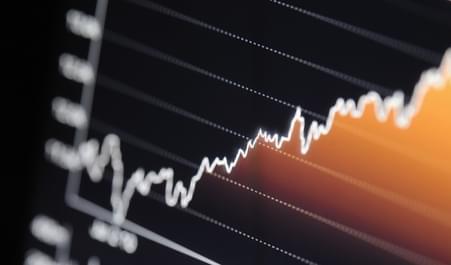One key factor, for example, is that some 80% of EM energy companies have de facto sovereign backstops, while US energy companies are going bust due to low oil prices. But there are other advantages for EM debt right now: the cyclical backdrop is improving in EM countries, while it is deteriorating in the US. Widespread fears that a surge in the US Dollar would expose FX mismatches on EM corporate balance sheets have also been misplaced, while the strong Dollar appears to be hurting US corporates. Yet, going forward a less bullish outlook for the Dollar might yet prove supportive for EM corporates, especially if capital begins to flow back to emerging markets. These temporary advantages are complemented by far better credit metrics for given credit ratings, including much lower net leverage. EM corporates, in short, offer superior value at current yields.
Lower default rates
Default rates for EM corporates have declined by nearly 2% relative to US corporates so far this year. Based on data from Bank of America Merrill Lynch (BAML) for the year to the end of March, EM default rates have declined by nearly one percentage point to 3.01%, while US default rates have increased to 4.62% from 3.57% at the end of 2015. The stronger relative performance is not just a recent phenomenon; at 3.9%, long-term default rates in EM are lower than in US HY markets (4.56%). EM corporate defaults have remained range-bound at or below their long-term average since 2010.
Dollar sensitivity
The stronger performance of EM corporates will surprise many. After all, the period from 2011-2015 has been characterised by challenging financing conditions in Emerging Markets. EM corporates have had to deal with tighter financial conditions, slower domestic growth and weaker home currencies. Fears of potential FX mismatches on corporate balance sheets in EM corporates have at times been elevated. Yet, US corporates now appear to have been far more sensitive to the strong Dollar than EM corporates. Despite much easier financing conditions, US corporates have fared particularly badly since the Dollar began to surge in the middle of 2014.
Macroeconomics Matter
EM’s dramatically lower currencies are now helping many EM corporates to compete, particularly since inflation is mostly under control across the EM universe. EM external balances are now improving, despite lower commodity prices, because EM countries are cheap places to produce. By contrast, the US has progressively become less competitive. US manufacturing is in recession and the services sector is showing signs of weakness. As the US moves closer to full employment the risk is rising that wages go up even as productivity wanes. Some 95% of US corporate profits are used to buy back stock and to pay dividends rather than as investment. In these regards, the US now looks like an economy where rates are already at 5%, expensive, uncompetitive and in need of reform.
Better Credit Quality
It is well-known that EM corporate credit ratings do not reflect the true credit quality, because corporate ratings are constrained by sovereign ratings ceilings. Despite this handicap, EM HY corporates are on average rated higher than US corporates. The average EM HY corporate is rated BB- compared to B+ for the average US HY corporate. EM corporates have much lower net leverage than their US counterparts – 2.5x versus 5.5x, respectively. EM corporates are also far more diverse than developed markets corporates by virtue of their greater number, countries and sectors.
Technical Tailwinds
Prices are determined by demand and supply, so technicals matter a great deal. In 2016, some US$158bn will be returned to investors in coupons and principal repayments in addition to an expected US$40bn-50bn in bond buybacks as local funding sources become more attractive than international ones. This means that between lower issuance and record repayments the market will be pushed into net negative supply this year. With many international investors underweight after years of EM pessimism the risk is that demand increases sharply as outperformance versus US corporate bonds continues.
Get Paid For The Risk
EM and US HY bonds today pay roughly the same yield of approximately 8%. At these yields, EM HY corporates offer superior value for the reasons outlined above. Value investing is about spotting the moment when prices get out of line with fundamentals. That time is now.
But What About Those FX Mismatches?
The Commentariat has been crying wolf about the risk a rising Dollar poses to EM corporate debt ever since the start of the US dollar rally against EM currencies in 2010. EM companies are supposed to have borrowed too much in Dollars. These fears were misplaced. Many EM corporates issue in Dollars because they are exporters with revenues in Dollars, so they actually reduce FX mismatches by creating liabilities in Dollars. Many EM corporates also actively hedge their FX exposures. Finally, many EM corporates have issued longer-dated bonds and used the proceeds to reduce short-term Dollar credit lines and bank loans, so net issuance is lower and rollover risks have declined.
Local Markets Matter Far More
In any case, the USD bond market is just one (small) part of several pools of capital that EM companies can tap into, and by no means the largest. Local bond markets are far more important and corporates can also tap local bank sources. Borrowing from international markets is often opportunistic, to be used as and when market conditions are attractive. Good EM companies tend to tap international markets when conditions are favourable. The ability of EM companies to survive without access to the USD bond market is often demonstrated, most recently by sanctioned Russian corporates that have been completely cut from refinancing in USD. Not only did Russian companies not go into default in 2015, they managed to pay everything in time and in full and conducted multi-billion USD buybacks of bonds.
The China Question
Chinese corporates have until recently maintained large naked Dollar exposures, unlike corporates in most other EM countries. Chinese corporates were able to borrow abroad at lower yields than at home, and did so. When China officially adopted a more flexible exchange rate regime ahead of SDR inclusion, and Chinese corporates refinanced at home in RMB at now much lower yields. Repayment of Dollar debt has reduced the stock of outstanding Dollar liabilities that a positive technical climate has been created, which has caused Chinese corporate bonds to outperform all other in EM so far this year.
Bottom-Line
EM corporates have withstood numerous headwinds in recent years without falling over. Many of these headwinds are now easing, while conditions are becoming more challenging in the US economy, not least due to the strong the Dollar. Investors are paid roughly the same in both markets, but EM corporates look much safer. The macroeconomic backdrop is improving in EM, credit quality is higher and the technical backdrop is favourable. Special circumstances, such as the sovereign backstop behind most EM energy companies, should ensure that EM corporates continue to have fewer defaults than their American counterparts. With FX mismatch fears and the China question fading amidst a growing realisation that EM corporates are not as dependent on global finance as previously thought, the question of where to seek yield has a ready answer: EM corporate bonds offer the superior combination of risk and return.









